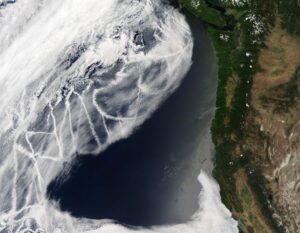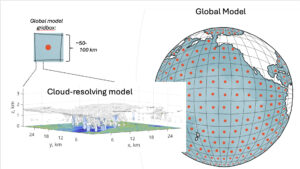Marine Cloud Brightening Research Program
The Marine Cloud Brightening Research Program is an open collaboration of atmospheric scientists and other experts to study how clouds respond to particles — also called aerosols — in the atmosphere.
This research aims to further our understanding of how interactions between aerosols and clouds impact our climate system, and to investigate the feasibility and potential impacts of reducing climate warming by intentionally increasing the reflection of sunlight from marine clouds. An overarching goal of the research is to provide open, objective scientific information to help improve society’s ability to understand the climate system and to address near-term climate risks.
Why study how particles (aerosols) affect clouds?
Clouds reflect sunlight back to space, which cools temperatures locally and across the planet. Sustained small changes in cloud cover or in the amount of sunlight reflected by clouds have the potential to change climate both locally and globally.
When aerosol particles in the atmosphere from both natural sources (such as biological emissions and sea spray) and human activities (such as from burning fossil fuels, wood and vegetation) mix into low clouds, particularly over the ocean, they can cause the clouds to brighten and thus reflect even more sunlight back into space. This has a cooling effect on the Earth’s climate.

Importantly, this role of aerosols in affecting sunlight reflection is changing. At the same time that humans are continuing to release climate-warming greenhouse gases into the atmosphere, expanding air quality regulations are leading to declines in the concentration of atmospheric aerosol particles. This is beneficial for public health and local ecosystems — at the same time, because most of these particles have a cooling effect on our climate, removing them generally adds to climate warming.
Atmospheric scientists are still not certain just how much of a cooling effect these aerosol particles have on the climate overall. Scientists estimate that aerosols from human emissions are offsetting 0.5℃ of global warming from greenhouse gases, but they could be cooling as little as 0.2 ℃ or as much as 1.0 ℃ (Forster et al., 2021). The uncertainty in this number leads to uncertainty about how much warming to expect in the coming decades.
If the effect of aerosols on clouds is large, reducing aerosol pollution might significantly accelerate climate warming in the very near term. One recent paper concluded that there has already been an acceleration in global warming due to the decline in atmospheric aerosols since 2010, and projects that between now and 2040 the rate of warming may double due to this effect (Hansen et al., 2023). Recent steep reductions in particulate pollution emissions from ships that coincided with record ocean surface and global temperatures have increased interest in understanding and quantifying these effects.
What is marine cloud brightening?

Scientific studies indicate that aerosols of the right size and concentration could significantly increase the reflectivity of specific types of clouds. This phenomenon is visible in satellite images of clouds brightened by ship emissions (known as “ship tracks”). Observations of ship tracks led scientists to the idea of using particles of salt from sea water, a natural source of cloud-forming aerosol particles, to brighten clouds over parts of the ocean in order to reduce climate warming.
In this approach, sea salt particles from the ocean would be sprayed from ships into areas of low-lying clouds. Once emitted, the particles would remain in the atmosphere for only a few days, within localized areas.
There are specific regions of the ocean with clouds that could be more favorable for brightening in this way, though it is still uncertain how much brightening could be achieved in different regions. If marine cloud brightening (MCB) were ever to be used, which areas are brightened, and by how much, would determine how much climate cooling could be produced, how climate changes would be affected by different implementations of MCB, and how MCB would affect climate impacts and risks.
Changes in clouds over broad regions affect the circulation of the atmosphere, weather and precipitation. Both MCB and pollution aerosols, by changing clouds, therefore will affect regions both near and far from the location of brightening. A critical aspect of understanding MCB and aerosol effects more broadly is improving the ability to project these long-distance effects and risks.
Our research

As humans consider making changes to our aerosol emissions — either reducing them via regulation and technology, or pursuing intentional marine cloud brightening as a climate intervention — we need a stronger scientific understanding of these processes in order to both advance positive effects and limit unintended effects.
The Marine Cloud Brightening Research Program is a scientific program, led by atmospheric scientists, that aims to simultaneously:
- Better understand the present-day effects of pollution aerosols on clouds
- Investigate whether aerosol particles made from sea salt could be used to intentionally reduce near-term climate warming while greenhouse gas concentrations are brought down to safer levels
- Understand the benefits, risks and efficacy of the intentional use of aerosols to reduce warming through different implementations of marine cloud brightening
The MCB Program includes multiple parallel research efforts in different areas to help achieve this, including:
- Improving the representation of aerosol-cloud interactions and marine cloud brightening in global computer models used to understand how these aerosol effects impact climate
- Studying how the climate is altered by changes in cloud brightness and cloud amount in different regions of the globe
- Using observations of real-world phenomena — such as ship emissions — that are already causing marine cloud brightening to better quantify aerosol-cloud interactions
- Conducting detailed simulations of aerosol-cloud interactions and testing these simulations against observations
- Exploring leading-edge analytical approaches, such as machine learning, to study the potential efficacy and effects of different marine cloud brightening approaches
- Conducting small-scale field studies of the interactions between aerosols and clouds, using the controlled addition of sea salt aerosols to the clouds, in order to test current understanding of the processes driving these interactions
- Developing a new cloud-aerosol research instrument for use in small-scale field studies. This new research instrument generates controlled volumes and sizes of tiny, sub-micrometer seawater particles in sufficient numbers to increase the local brightness of low clouds in a marine environment
Our approach
In addition to advancing its scientific goals, the MCB Program’s intent is to serve as an exemplary model for open, public-interest research and field studies of clouds and aerosols, and as a resource for scientists, regulators, stakeholders and the public for understanding and engaging with cloud-aerosol and marine cloud brightening research. Appreciating the importance of engagement with international, climate-vulnerable, youth and historically underserved partners, the program supports and fosters diverse and inclusive engagement and input.
The MCB Program’s open science, governance and stakeholder engagement efforts include:
- Open datasets and peer-reviewed publications
- Collaboration and engagement with US federal agencies and US and international scientific assessment processes
- International scientific collaborators
- Scientific and environmental expert review of field studies
- Engagement with Global South and Indigenous Peoples on field science
- Youth partners and forward development of STEM education programs
- Provision of a facility for scientific research, engagement and learning
Read more about our governance, engagement and the CAARE facility here.
Our team
The MCB Program is led by atmospheric scientists Robert Wood and Sarah Doherty at the University of Washington, and is comprised of over 35 interdisciplinary experts from the UW, SRI International (formerly the Palo Alto Research Center) and SilverLining. The Program also collaborates with researchers at a range of other institutions, including the Pacific Northwest National Laboratory, University of Victoria (Canada), the Desert Research Institute, and the University of Exeter (UK).
Funding
The University of Washington’s Marine Cloud Brightening Research Program is funded by SilverLining’s Safe Climate Research Initiative and the generous support of a growing consortium of individual and foundation donors.
Read more about our team, partners and funders here.